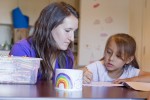The red dye trickled slowly through the cotton-filled test tube like blood traveling through clogged arteries.
Joseph Esdin remembered comparing the sluggishly moving dye to its quickly advancing analogue in an empty test tube during the early days of a community service club he founded as a UCLA undergraduate student. He wanted the children he was teaching to see how eating fatty food can clog blood vessels.
Fifteen years later, Esdin is now a physiological science professor at UCLA and the faculty adviser of the club he had once started. Esdin uses similar examples in classes he teaches to members of the club about health outreach and education to at-risk populations, he said.
“The cell biology part is very important. But we can’t use those big names with 10-year-olds because we’re going to lose their attention,” Esdin said. “We have to simplify it using analogies and games.”
Interns in the Together Educating and Advocating Community Health, or TEACH, program create health-based lesson plans and tutor at-risk children in the Venice community by applying the techniques they learn in Esdin’s classes.
After taking Esdin’s class for credit in the first of three quarters participating in TEACH, students begin their field work where they present similar lesson plans and mentor elementary and middle school children. In the final quarter, students take a class that focuses on health issues such as social security and the health care system while continuing to visit the site.
Many of the children who attend the TEACH program come from underserved areas, said Kathy Sanchez, a site supervisor for TEACH from the Venice Community Housing Corporation.
The club provides a positive environment for the children and educates them about the problems with unhealthy lifestyles, said Harleen Sethi, a recent graduate in human biology and society and former president of the club.
The club ensures that some interns are in Venice four days a week for a few hours each afternoon to give the educational help that the community cannot necessarily provide on its own.
TEACH interns present the lesson plans they create to elementary and middle school children on everything from sound instruments and diabetes.
Sometimes the interns will use blocks of sugar corresponding to the amount found in drinks to explain how consuming sugary drinks can be bad for you, Sethi said.
Esdin, who is now the faculty adviser for the club, said he started it in 1997 because there was no mentorship program that focused on community health at UCLA.
He said he decided to target the Venice children because of their close proximity to the campus.
“We wanted to connect both groups – the students who are eager to help and the community that is really in a dire necessity to receive,” Esdin said.
The Community Activities Committee, which is a part of the Center for Student Programming, provides about $9,000 to fund the program.
TEACH interns can use the money to get supplies, such as food, for their modules, said Ashley Hilton, a fourth-year art history student.
Hilton said she enjoyed teaching the children about diet and exercise and helping them with their school work.
A few weeks ago, Hilton said she sat down with one of the children who was frustrated when she could not understand how to do a math project, which involved enlarging a picture.
“It was so disheartening seeing her give up,” Hilton said. “But (the following) week, she came back and it was all done.”
Although her internship is coming to an end, Hilton said she plans on applying to be a site coordinator for the program next year.
“(TEACH) helps the children grow and mature in a healthy environment and get a broader education beyond just science, math and English,” Hilton said.
Contributing reports by Vishaka Sriniwasan, Bruin contributor.
